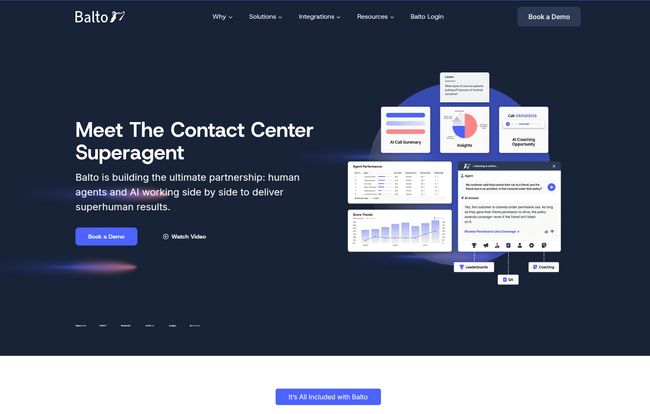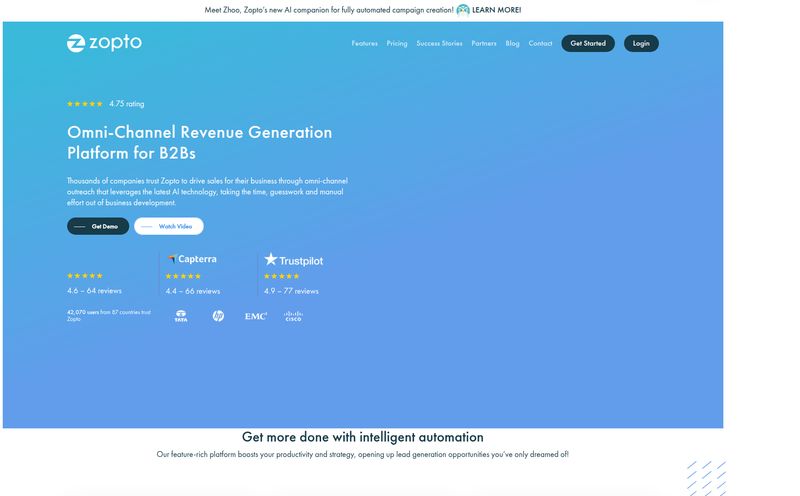We’ve all been there. On the phone with customer service, getting bounced between departments, re-explaining our issue for the fifth time. You can almost hear the agent frantically clicking, typing, and putting you on hold. It’s frustrating for us, and honestly, it’s a nightmare for them. I had a brief, terrifying stint working in a call center during college, and the pressure to know everything, say the right thing, and do it all quickly is immense. Agent burnout isn't a myth; it’s a feature of the old system.
For years, the solution has been more training, more scripts, and more post-call analysis. We listen to calls after the fact, find mistakes, and then coach agents days later. It’s like telling a quarterback what he did wrong on Tuesday when the game was on Sunday. Helpful? Maybe. Effective? Not really.
But what if there was a co-pilot in the cockpit with the agent on every single call? That’s the promise of a tool I've been digging into lately: Balto AI. It's not just another analytics dashboard. It’s real-time, on-the-fly guidance, and it might just be the thing that pulls contact centers into the 21st century.
What Exactly is Balto AI? (And Why Should You Care?)
Think of Balto as a GPS for customer conversations. It sits in the background of a call, listening to both the agent and the customer. As the conversation unfolds, it provides the agent with dynamic information right on their screen. We're talking about the best questions to ask, key product info, compliance checklists, and even smart rebuttals to common objections. All in real time.
This isn’t about replacing agents with robots. I've always felt the best tech is the kind that empowers people, and that seems to be the philosophy here. It's designed to make good agents great and to get new agents up to speed in record time. It automates the tedious stuff—like quality assurance and note-taking—so humans can focus on the human part of the job: empathy and problem-solving.
It integrates with most major CRM and phone systems, so it’s not some standalone island of tech you have to force into your workflow. It plugs right in, which is a huge plus in my book.
Tearing Down the Old Walls: How Balto Fixes Contact Center Headaches
The Balto website has this whole series of “No More...” statements that really hit home. It’s a brilliant way to frame what they do, because they’re targeting the exact pain points every contact center manager loses sleep over. Let’s break them down.
Instant Insights Without the Detective Work
Traditionally, if you wanted to know why customers were calling about a specific issue, you’d have to pull call logs, listen to a random sample, and maybe, just maybe, spot a trend. It’s slow and wildly inefficient. Balto flips this on its head. Because it's analyzing 100% of conversations, it can spot trends as they happen. Is everyone suddenly asking about a new billing fee? You’ll know in hours, not weeks. This shifts managers from being historical detectives to proactive problem solvers.
Smarter Coaching That’s Actually Relevant
Random call listening for coaching is a shot in the dark. You might listen to five perfect calls from an agent who is struggling with one specific scenario you never get to hear. It's a waste of time. Balto identifies the exact moments where an agent could have done better. For example, it can flag when an agent missed a chance to show empathy or forgot to mention a key feature. This allows for hyper-specific, targeted coaching that actually sticks. You’re not just saying “be more confident,” you’re saying “On that last call, when the customer mentioned they were frustrated, here’s a phrase that could have helped…” That's a world of difference.
A Real-Time Safety Net for Agents
Let's be real, being a new agent is terrifying. You’re trying to navigate complex software while a possibly angry customer is on the line. It's a recipe for disaster and long hold times. Balto acts as a safety net. When a customer asks a tough question, the answer can pop up on the agent’s screen. If they’re on a call that requires a strict compliance script, Balto can display a checklist and tick items off as they're spoken. This reduces agent anxiety and ensures a consistent, compliant customer experience every single time.

Visit Balto AI
It’s about confidence. An agent who knows they have backup is going to be a more effective, and probably happier, agent. And in an industry with notoriously high churn rates, agent satisfaction is not a soft metric; it’s a business imperative.
Ditching the Drudgery of Manual Work
Two of the most soul-crushing tasks in a contact center are manual call scoring and writing post-call notes. It’s tedious, subjective, and takes away from time that could be spent on higher-value tasks like coaching. Balto automates both. It can score calls based on custom criteria and generate accurate, concise summaries of the entire conversation. Think about what a supervisor could do with all that reclaimed time. It’s huge. It's teh difference between managing a team and just managing a pile of administrative tasks.
The Good, The Bad, and The Realistic: My Take on Balto AI
Okay, so it sounds pretty great on paper. And for the most part, I think it is. The ability to provide real-time guidance is, without a doubt, a massive leap forward. The impact this could have on things like First Call Resolution (FCR) and Customer Satisfaction (CSAT) is obvious. Agents are better prepared, more consistent, and more compliant. Managers can actually manage people instead of spreadsheets. It’s a win-win.
However, let’s not pretend it's a magic wand. There are a few realistic hurdles to consider. First, there's the initial setup. While Balto claims “no setup,” that's a bit of marketing speak. You still have to integrate it and, more importantly, build out your knowledge base. The AI is only as smart as the information you give it. If your playbooks and best practices are a mess, Balto will just be serving up a mess in real-time. Garbage in, garbage out, as they say.
There's also the human element. Some veteran agents might resist the idea of an AI “telling them what to do.” The rollout needs a thoughtful change management strategy. You have to frame it as a supportive tool, a co-pilot, not as Big Brother watching their every move. If you get agent buy-in, it'll fly. If you don't, you're in for a bumpy ride.
Let's Talk Money: What's the Deal with Balto's Pricing?
This is the million-dollar question, isn't it? If you're looking for a simple pricing page with neat little tiers, you wont find it. Balto, like a lot of enterprise-grade B2B software, doesn’t list its pricing publicly.
And honestly, that makes sense. The cost is going to depend heavily on the size of your team, the specific features you need, your call volume, and the level of integration required. A 500-seat contact center has very different needs than a 50-seat one. Instead of a one-size-fits-all price, they want you to book a demo. This allows them to understand your specific pains and craft a custom quote. While I always prefer transparent pricing, I get the logic here. My advice is to go into that demo with a clear understanding of your key metrics and what you hope to improve.
So, Is Balto AI Right for Your Team?
After looking at it all, who is this really for? I think Balto AI is a fantastic fit for medium to large contact centers, especially those in industries with heavy compliance burdens like finance, healthcare, or insurance. If you’re struggling with long agent ramp-up times, inconsistent service quality, or high agent churn, this is definitely something you should be looking at.
If you're a very small team of, say, 5 agents who all sit next to each other and have incredibly simple, repetitive calls, it might be overkill. But for any operation at scale, the potential for improvement in efficiency and quality is massive.
Ultimately, Balto represents a shift from reactive to proactive management. It’s about fixing problems as they happen, not a week later. It's about giving agents the tools to succeed in the moment, and that’s a powerful change that could redefine what a successful contact center looks like.
Frequently Asked Questions about Balto AI
- What is Balto and how does it assist agents during calls?
- Balto is a real-time AI software that listens to customer calls and provides live guidance to agents. It displays prompts, checklists, and important information on their screen to help them handle conversations more effectively and ensure they follow best practices and compliance rules.
- Does Balto integrate with my current CRM and phone systems?
- Yes, Balto is designed to integrate with a wide range of popular CRM and phone systems. This allows it to work seamlessly within your existing tech stack, pulling customer data and pushing call summaries without requiring agents to juggle multiple applications.
- How does Balto AI handle compliance and sensitive information?
- Compliance is a core feature. Balto helps by providing agents with dynamic scripts and checklists to ensure they say everything that's legally required. It can also be configured to redact sensitive information like credit card numbers from recordings and transcripts to maintain PCI compliance.
- Is Balto difficult for new agents to learn?
- The opposite is actually true. One of Balto's main benefits is reducing the learning curve for new agents. By providing on-screen guidance, it acts as a 'safety net,' helping new hires feel more confident and become proficient much faster than with traditional training methods alone.
- How does Balto automate Quality Assurance (QA)?
- Instead of managers listening to a small, random sample of calls, Balto analyzes 100% of them. It automatically scores interactions based on your specific criteria, identifies coaching opportunities, and surfaces trends, saving quality teams a massive amount of manual work.
- What is the implementation process for Balto like?
- The implementation process involves integrating Balto with your phone and CRM systems and then building out your 'Playbooks'—the content and rules that Balto uses for guidance. While Balto's team assists with this process, its effectiveness depends on having well-defined best practices to load into the system.
Reference and Sources
- Balto AI Official Website
- Gartner on Conversational AI in the Contact Center
- Zendesk Blog: Why the agent experience is the heart of customer service



